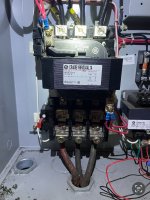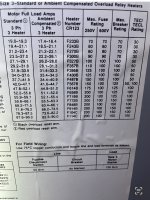You are using an out of date browser. It may not display this or other websites correctly.
You should upgrade or use an alternative browser.
You should upgrade or use an alternative browser.
Undersized thermal protection for motors
- Thread starter darekelec
- Start date
- Status
- Not open for further replies.
ptonsparky
Tom
- Occupation
- EC - retired
No, size it to the FLA of the nameplate.The new motor has a service factor of 1.15 . (Info is covered by a shipping sticker)
Am I correct to size OL at :
76x1.15= 87.4
So the value of OL should not be higher than 87.4 ?
See Post 16 & 17.
Adding another 12 amps of overload will extend the trip range out even more.
ptonsparky
Tom
- Occupation
- EC - retired
Service factor "refers to the capacity of a motor to operate efficiently beyond its rated capacity for short periods."If a nameplate says
20 hp motor
76 amps
1.15 service factor
What’s the max value of OL?
IDK what short periods are. 15 minutes, 60? maybe.
24/7? No.
I've seen the 1.25 SF included for irrigation wells. I was usually there because the motor smoke had escaped.
winnie
Senior Member
- Location
- Springfield, MA, USA
- Occupation
- Electric motor research
Not quite.
Service factor is a continuous rating, and basically describes the level you can operate a motor at continuously if you disregard all the other features that go into the horsepower rating.
Service factor is a continuous rating, and basically describes the level you can operate a motor at continuously if you disregard all the other features that go into the horsepower rating.
ptonsparky
Tom
- Occupation
- EC - retired
You would know. i only know what I’ve read and based on experiences.Not quite.
Service factor is a continuous rating, and basically describes the level you can operate a motor at continuously if you disregard all the other features that go into the horsepower rating.
What are the other factors? Ambient?
kwired
Electron manager
- Location
- NE Nebraska
- Occupation
- EC
There is also a time factor in the trip curve.Thermal overloads have an inherent +/- 1% repeat accuracy, that's why. If we do a quick math there, 56A setting would mean the tripping amps will be 1.15 X 56 = 64.4. But because of the inherent reproducibility of 1%, the thermal overload needs 64.4A X 1.01 = 65.044A ->thermal overload doesn't trip at just 65A! If your current meter also has an indication error of +/- 10%. 65A could be just 60A, it couldn't be 71.5A since the thermal overload didn't trip. As said by the person above me, small things matter, we're in a real world. If you want a tighter protection, set your thermal overload lower than the expected overload.
Motor overloads are intended to have similar characteristics as the motor they are protecting. A small overload takes time for heat to build up to damaging levels in the motor therefore a small overload should take similar time before the overload protection opens the circuit.
kwired
Electron manager
- Location
- NE Nebraska
- Occupation
- EC
Look at speed rating - it is an 8 pole motor and the Baldor motor has a pretty low power factor marked on nameplate.That sure makes it code legal, as odd as it is to have such a wide variation in current for the "same" motor.
I take back what I said earlier that there was no way they were same HP, I was presuming typical 2 to 4 pole motors when I said that.
kwired
Electron manager
- Location
- NE Nebraska
- Occupation
- EC
One right across road from where I live was calculated to need a 125 HP motor when they converted to electric, that was maybe about 12 years ago. I explained to owner POCO wants soft start on anything above 100 HP, he got back to me and said they are changing sprinkler package and that 100 HP should be fine. When we were all done with the 100 HP install, it was drawing too much, but still within the SF. I warned him this would likely shorten life of that motor. So far it is still going though. I'm sure if it were something that ran year round it maybe would have failed by now. Of course you do know that these can and do run 24/7 at times for a couple months in the warmest part of the year.Service factor "refers to the capacity of a motor to operate efficiently beyond its rated capacity for short periods."
IDK what short periods are. 15 minutes, 60? maybe.
24/7? No.
I've seen the 1.25 SF included for irrigation wells. I was usually there because the motor smoke had escaped.
Anybody may want to take a hit on this question?If a nameplate says
20 hp motor
76 amps
1.15 service factor
What’s the max value of OL?
Thank you for other answers. They are very informative.
ptonsparky
Tom
- Occupation
- EC - retired
I applied various PF and efficiency to the original motor and came up with 20HP! Imagine that. Eff lower with PF higher than replacement.Look at speed rating - it is an 8 pole motor and the Baldor motor has a pretty low power factor marked on nameplate.
I take back what I said earlier that there was no way they were same HP, I was presuming typical 2 to 4 pole motors when I said that.
kwired
Electron manager
- Location
- NE Nebraska
- Occupation
- EC
If you using manufacturer charts for melting alloy units you simply use nameplate FLA and make selection from the chart, at least that is normal for service factor of 1.15 or 1.25. A motor with SF of 1.0 they often tell you to multiply nameplate amps by .90 then use that number to make a selection from the chart.Anybody may want to take a hit on this question?
Thank you for other answers. They are very informative.
If you have an overload with a dial for selecting setting you normally match that to nameplate. again with a SF of 1.0 you may need to multiply by .90 and then use that result.
kwired
Electron manager
- Location
- NE Nebraska
- Occupation
- EC
Seems like it would be an expensive motor up front for anything belt driven, which OP said it was a belt driven blower.I applied various PF and efficiency to the original motor and came up with 20HP! Imagine that. Eff lower with PF higher than replacement.
kwired
Electron manager
- Location
- NE Nebraska
- Occupation
- EC
Not all that familiar with GE. There is likely instructions on those labels somewhere that tells how to set that dial.Based on your advice I conclude that max overload would be F104C
Dialed down a bit. Starter has a small white dial (above red reset handle) that can be set between 90 to 110 (I assume percent value of thermals)
winnie
Senior Member
- Location
- Springfield, MA, USA
- Occupation
- Electric motor research
You would know. i only know what I’ve read and based on experiences.
What are the other factors? Ambient?
My understanding is that the 'horsepower rating' includes things such as starting and pull-up torque requirements, allowed ambient temperature, allowed operating voltage range, etc.
Service factor means take away all of your headroom/tolerance/margin of error but if you run at rating * SF the motor will remain below rated temperature.
I just did a Google search and found several references to the 'short time operation' definition. I'm going to have to dig out my copy of MG1 and double check.
Jonathan
Jpflex
Electrician big leagues
- Location
- Victorville
- Occupation
- Electrician commercial and residential
But larger motor nameplate will require larger overload heaters regardless of load amperes FLA less than nameplate FLA per code and would be a possible NEC violationMax size of heaters is per nameplate amps. No issue going smaller.
ptonsparky
Tom
- Occupation
- EC - retired
430.32(A)(1)...selected to trip or shall be rated at no more than...But larger motor nameplate will require larger overload heaters regardless of load amperes FLA less than nameplate FLA per code and would be a possible NEC violation
Overloads can be smaller.
kwired
Electron manager
- Location
- NE Nebraska
- Occupation
- EC
Not a NEC violation to under protect the motor.430.32(A)(1)...selected to trip or shall be rated at no more than...
Overloads can be smaller.
But let's just say that if OP's motors were loaded to 20 HP of output the one will need higher setting than the other if you don't want it to trip. This is all about efficiency and power factor differences even though mechanical output is the same. And the HP rating is the mechanical output rating.
- Status
- Not open for further replies.


